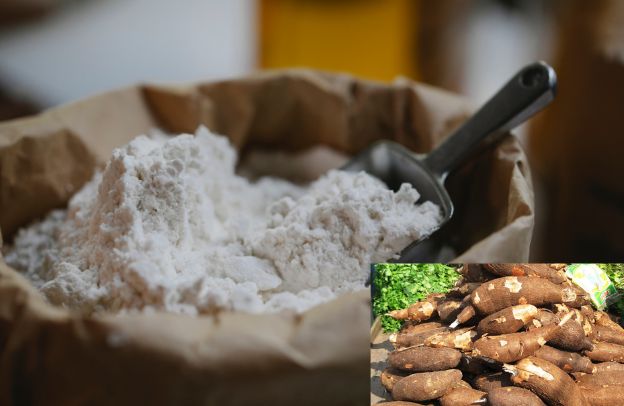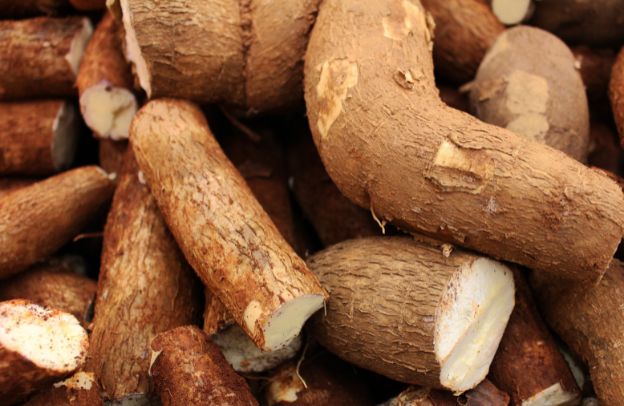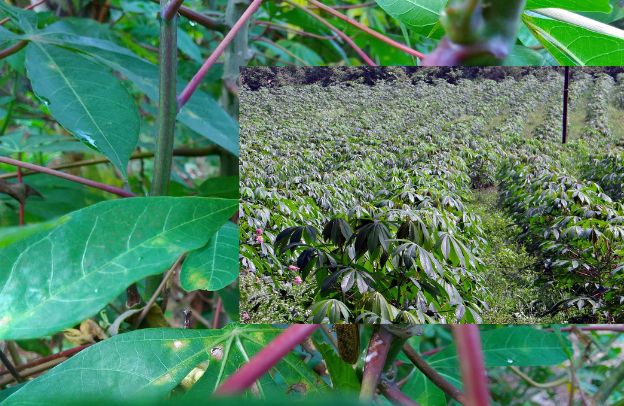Maximizing Cassava Yield: Fertilizer Application Strategies for Small-Scale Farmers in Nigeria

Cassava is a vital crop to Nigeria’s agricultural economy, providing food security and a source of income for many small and medium-scale farmers. However, cassava yield has been limited due to several environmental factors, pests, and diseases.
Fertilizer application has proven to be an effective way to increase cassava yield, but small-scale farmers often lack the knowledge of the right fertilizer application strategies.
In this article, we will provide an overview of fertilizer application strategies for cassava to maximize yield for small and medium-scale farmers in Nigeria. We will explore the different types of fertilizers suitable for cassava, the application rates, timing, and methods, as well as best management practices for cassava yield improvement.
This article is designed to help small and medium-scale farmers take advantage of fertilizer application to increase cassava yield and improve their livelihoods.
Understanding Cassava
Cassava is a versatile crop with many varieties, ranging from sweet to bitter. The sweet varieties are consumed as food, while the bitter ones are mainly used for industrial purposes. Some popular varieties in Nigeria include TMS 30572, TME 419, and TMS 98/0505. The choice of variety depends on the intended use, soil type, and environmental conditions.
B. Environmental Factors Affecting Cassava Growth Cassava can grow in a wide range of environmental conditions, but some factors can limit its growth and yield. These include temperature, rainfall, soil type, and altitude.
Cassava grows well in tropical and subtropical regions with temperatures between 25°C and 35°C. It requires a minimum of 500mm to 1000mm of rainfall per annum with good distribution throughout the growing season. It also prefers well-drained soils with a pH between 5.5 and 6.5.
C. Factors Affecting Cassava Yield Several factors can affect cassava yield, including soil fertility, pest and disease infestation, and planting materials. Poor soil fertility can lead to stunted growth and low yield. Pests and diseases such as cassava mosaic disease, cassava bacterial blight, and mealybugs can cause significant yield losses.
Using healthy planting materials such as stem cuttings from disease-free plants is essential for good yield. Other factors such as planting density, weed control, and harvesting methods can also impact yield. Understanding these factors is critical in developing effective fertilizer application strategies to maximize cassava yield.
Importance of Fertilizers in Cassava Production
The Role of Fertilizers in Cassava Yield Improvement Fertilizers plays a crucial role in improving cassava yield by providing the necessary nutrients that the crop needs for growth and development. The three primary macronutrients required for cassava growth are nitrogen (N), phosphorus (P), and potassium (K).
Fertilizers can also provide secondary nutrients such as calcium, magnesium, and sulfur, as well as micronutrients such as iron, zinc, and copper. Applying the right fertilizer at the right time can significantly increase cassava yield and improve the quality of the harvested roots.
Nutrient Composition of Cassava Cassava is a crop that requires a balanced supply of nutrients for optimal growth and yield. It is a good source of carbohydrates and fiber but is relatively low in protein and other essential nutrients.
Cassava roots also contain small amounts of nitrogen, phosphorus, and potassium, as well as calcium, magnesium, and sulfur. Therefore, supplementing the soil with the right fertilizers can help to correct any nutrient deficiencies and enhance the nutritional quality of the harvested roots.
Types of Fertilizers Suitable for Cassava There are different types of fertilizers suitable for cassava, including organic and inorganic fertilizers. Organic fertilizers such as animal manure, compost, and crop residues are good sources of nutrients and can improve soil fertility.
Inorganic fertilizers such as urea, diammonium phosphate, and potassium chloride provide essential nutrients in concentrated forms and are usually faster-acting than organic fertilizers.
It is essential to choose the right type of fertilizer based on the nutrient requirements of the crop, soil type, and environmental conditions. A soil test can help to determine the appropriate fertilizer type and application rates.
Fertilizer Application Strategies for Cassava
Before applying any fertilizer to cassava, it is essential to conduct a soil test to determine the nutrient status of the soil. Soil testing helps to identify any nutrient deficiencies or imbalances that may limit cassava growth and yield. It also helps to determine the appropriate fertilizer type, application rates, and timing.
Selection of Fertilizer Type The choice of fertilizer type depends on the nutrient requirements of the crop and the soil test results. Inorganic fertilizers are usually faster-acting than organic fertilizers, but organic fertilizers can help to improve soil fertility in the long term.
It is essential to choose a fertilizer type that provides the necessary nutrients in the right amounts and ratios.
Application Rates and Timing The application rates and timing of fertilizer are critical in maximizing cassava yield. Applying too much fertilizer can lead to nutrient imbalances and environmental pollution while applying too little can result in low yield.
The recommended fertilizer application rates and timing depend on the stage of growth, soil type, and nutrient requirements of the crop. Splitting the fertilizer application into several doses throughout the growing season can help to improve nutrient uptake and utilization.
Application Methods There are different fertilizer application methods, including broadcasting, banding, and foliar application. Broadcasting involves spreading the fertilizer evenly over the soil surface, while banding involves placing the fertilizer in a narrow band along the planting row.
The foliar application involves spraying the fertilizer solution directly on the leaves of the crop. The choice of application method depends on the fertilizer type, soil type, and environmental conditions.
Fertilizer Placement Techniques The placement of fertilizer in the soil can also impact cassava yield. Deep placement of fertilizer can help to reduce nutrient losses through leaching and improve nutrient uptake by the roots.
In contrast, a surface application can result in nutrient losses through runoff and erosion. It is essential to use appropriate placement techniques, such as side-dressing, to ensure maximum fertilizer uptake by the roots.
Best Management Practices for Cassava Yield
Crop rotation is a critical practice in cassava production that can help to improve soil fertility and reduce disease and pest pressure. Rotating cassava with leguminous crops such as beans or cowpeas can help to fix nitrogen in the soil and provide organic matter. It is essential to avoid planting cassava continuously in the same field as this can lead to soil nutrient depletion and the buildup of pests and diseases.
Weed Management Weeds compete with cassava for nutrients, water, and light, and can significantly reduce yield.
Effective weed management practices, such as hand weeding, hoeing, or herbicide application, can help to reduce weed pressure and improve cassava yield. It is important to weed cassava fields regularly, especially during the early growth stages, to prevent weeds from taking over.
Disease and Pest Management Cassava is susceptible to various pests and diseases, which can significantly reduce yield if not properly managed. Integrated pest and disease management practices, such as the use of resistant varieties, biological control agents, and cultural practices, can help to reduce pest and disease pressure.
It is also important to monitor cassava fields regularly for any signs of pests and diseases and take appropriate action when necessary.
Harvest and Post-Harvest Management The timing and method of cassava harvest can affect yield and quality. Harvesting cassava when the roots are mature but not overripe can help to ensure maximum yield and quality. Proper post-harvest handlings, such as washing, drying, and storage, can help to reduce post-harvest losses and maintain the quality of the harvested roots. It is essential to handle cassava roots carefully to avoid bruising, which can reduce their shelf life.
Conclusion on Maximizing Cassava Yield: Fertilizer Application Strategies for Small-Scale Farmers in Nigeria
In conclusion, maximizing cassava yield requires a combination of good agronomic practices, including proper fertilizer application, weed, disease, and pest management, and harvest and post-harvest management.
Effective fertilizer application strategies, such as soil testing, selection of appropriate fertilizer type, application rates and timing, application methods, and fertilizer placement techniques, can significantly improve cassava yield.
The Importance of Fertilizer Application in Cassava Yield Improvement Fertilizer application is critical in cassava production, as it provides the necessary nutrients for plant growth and development. Using appropriate fertilizer application strategies can help to improve cassava yield, increase crop quality, and boost farmer income.
Call to Action for Small-Scale Farmers Small-scale farmers in Nigeria can benefit significantly from proper fertilizer application in cassava production.
It is essential to seek expert advice on fertilizer selection, application rates and timing, and application methods to ensure maximum yield and economic benefits. Small-scale farmers can also explore fertilizer subsidy programs and other government initiatives to improve access to quality fertilizers.
By adopting good agronomic practices and embracing innovation, small-scale farmers can improve their livelihoods and contribute to national food security.






